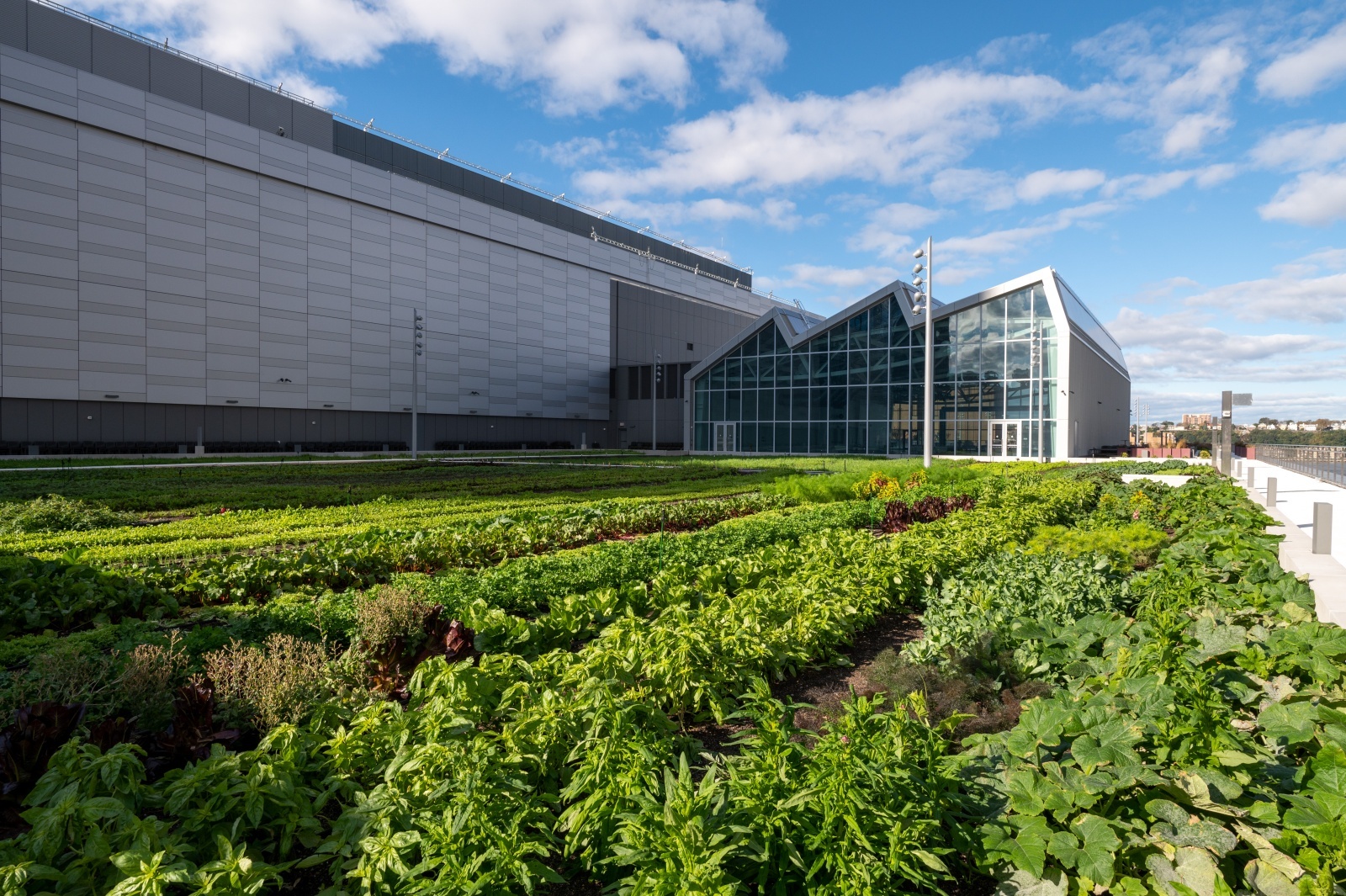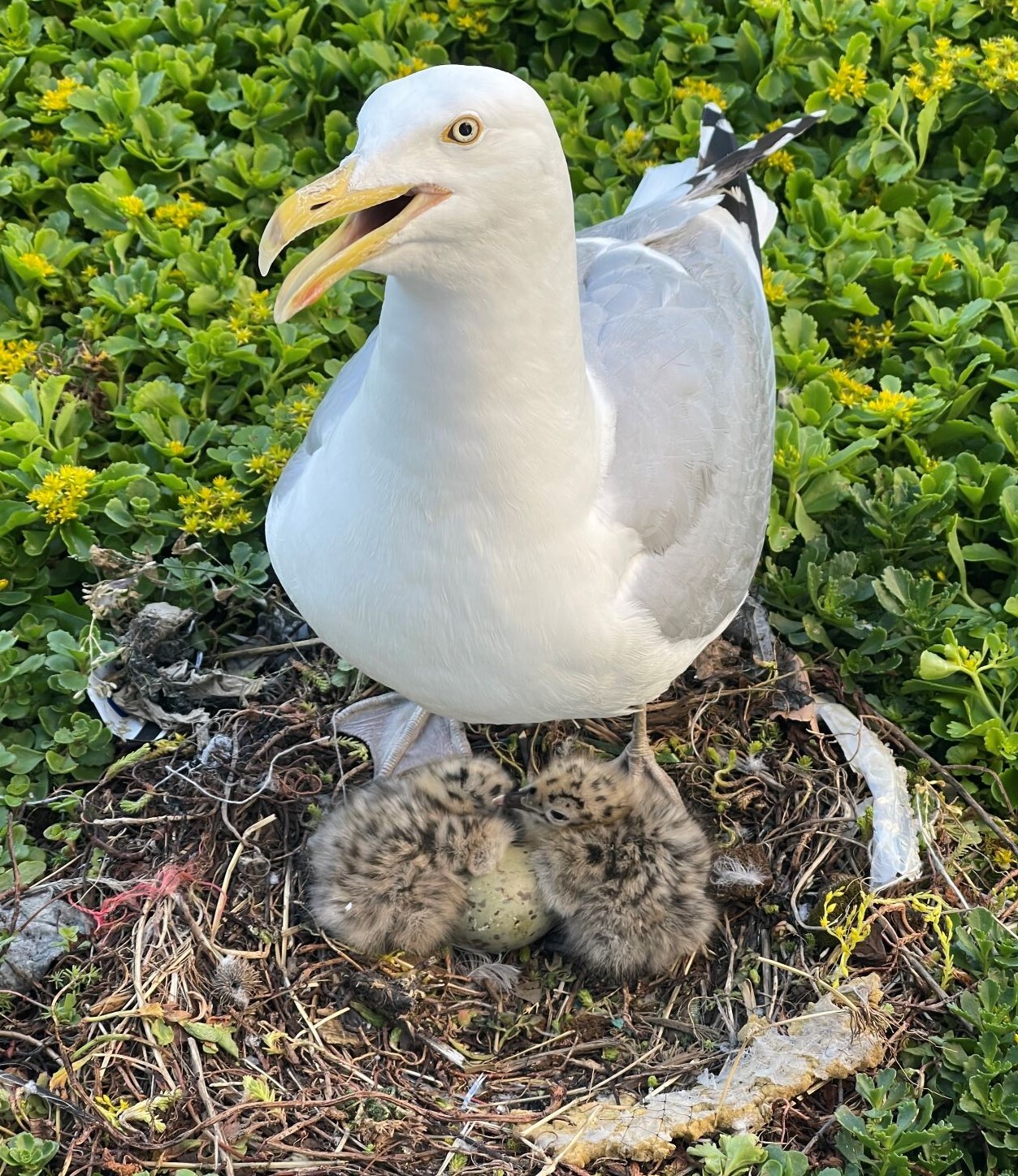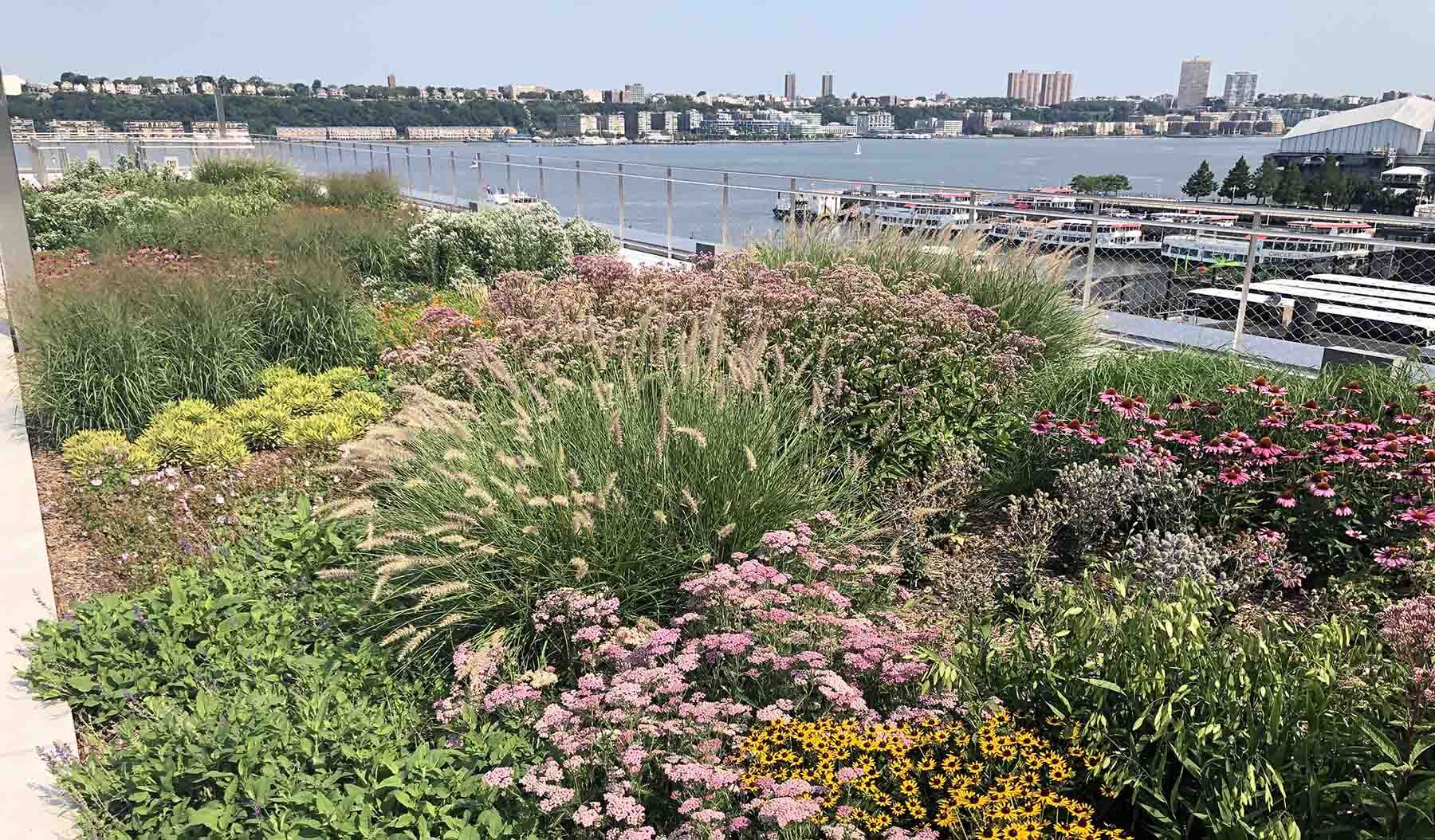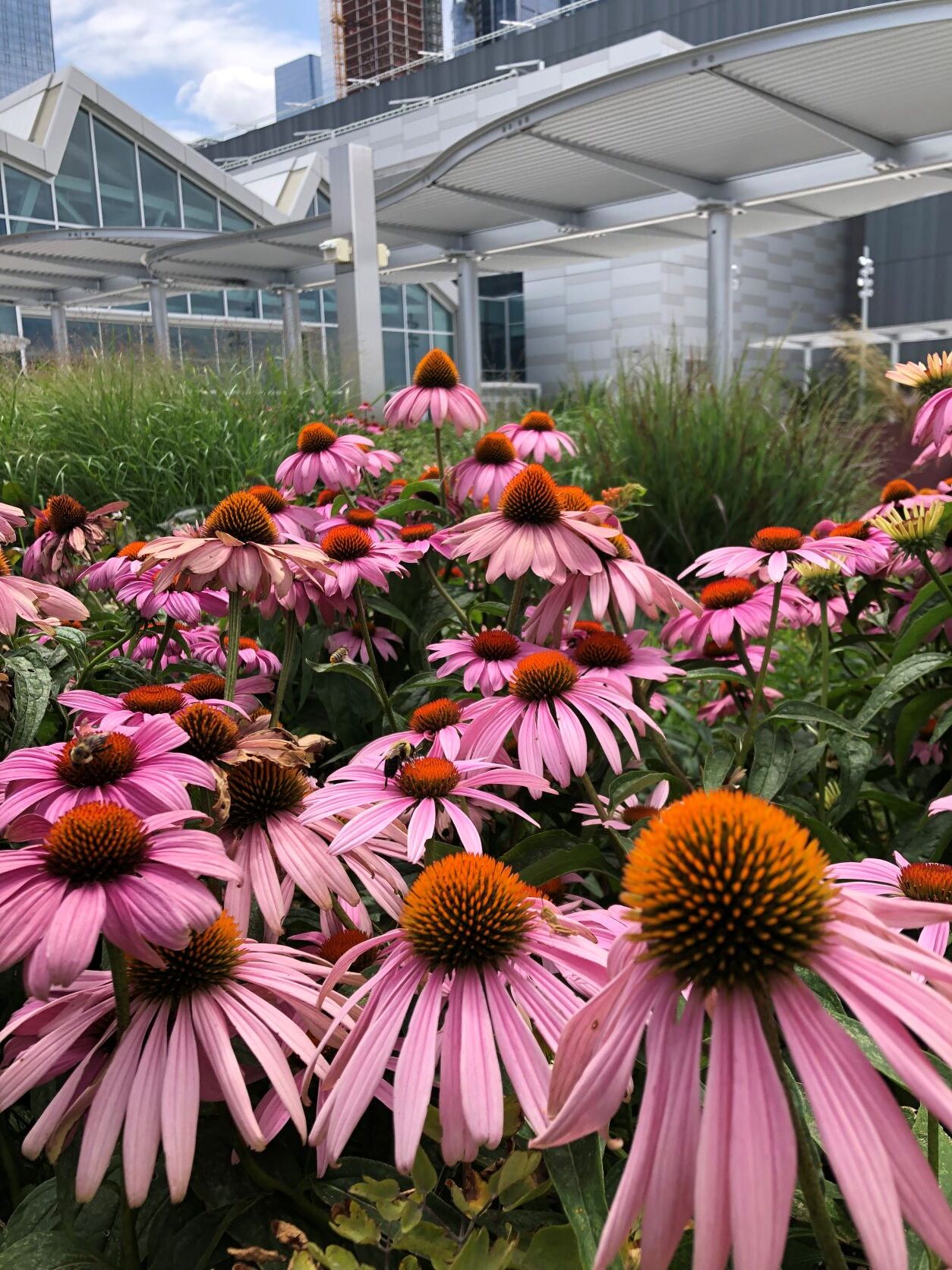The Javits Center: Leading from the Rooftops
category: CONSERVATIONURBAN AUDUBON
The Javits Center green roof hosted 150 pairs of nesting Herring Gulls in 2022. Photo: Javits Center
THE JAVITS CENTER: LEADING FROM THE ROOFTOPS
This article appears in the fall 2022 issue of The Urban Audubon.
By Suzanne Charlé
On Tuesday, September 20, 2022 NYC Audubon supporters and partners mingled in an urban farm high above the Hudson River, surrounded by an apple orchard, pear trees, and rows of arugula, zucchini, and other vegetables. The green-roof pavilion atop the Javits Center’s new addition was the site of the 18th annual Fall Roost, honoring the Javits Center’s major contribution to the environment and to the City’s population—both avian and human.
“There’s no better place to tell the story of NYC Audubon’s partnership with the Javits Center, and to honor the Center’s pioneering path,” said Executive Director Jessica Wilson. The success, backed by research, shows the benefits of green roofs and bird-friendly design, providing green space for biodiversity as well as energy savings for the Center.
“It’s an inspiring model,” she added. “Right now, such a tiny percentage of the City’s buildings have a green roof. There’s so much opportunity.”
This was the second Fall Roost at the Javits Center. The first, in 2014, recognized the Javits Center’s renovation, designed by FXFowle/Epstein, with bird-safe, low-reflecting, fritted glass and a nearly seven-acre green roof, the largest in New York State. Dustin Partridge, PhD, NYC Audubon’s director of conservation and science, observes that before the 2014 retrofit, the Javits Center was one of the City’s major bird killers; today, “it is one of the most bird-friendly and environmentally sustainable buildings in the City.”
In fact, after the Javits Center’s renovation, NYC Audubon’s Project Safe Flight monitoring revealed a striking 90 percent reduction in collisions at the Center. This research finding was used to support the 2020 passage of New York City’s Local Law 15, which requires bird-friendly glass on all new construction. And thanks in part to seven years’ worth of NYC Audubon’s biodiversity monitoring data from the Javits Center, the New York City Council passed Local Laws 92 and 94, requiring all new construction to have 100 percent green roofs or solar panels, or a combination of both. Developers and property managers in New York City and across the nation are looking to the Javits Center as a guide.
NYC Audubon researchers started studying the Javits green roof’s benefits to wildlife in 2014, shortly after the roof was completed. Since then, 65 bird species, 5 bat species, and hundreds of arthropod species have been observed using the roof. The abundance of wildlife on the roof has led to complex interactions, observed by researchers, such as a predator–prey relationship between bats and moths.
The roof also has a large Herring Gull colony, which in 2022 consists of 150 nests and provides a way for NYC Audubon scientists to study methods of population management. Dr. Partridge, working with the Javits Center, established conservation areas where the birds are welcome to nest and are banded by NYC Audubon staff, who use various gentle techniques to deter the gulls from nesting in areas with sensitive equipment. This year, the methods employed by field technicians Allison Starks and Wesley Craig have included a coyote decoy and an “eagle kite.” (Once any eggs are laid, however, the nests are left undisturbed. When the chicks hatch, anyone working on the roof—including workers installing solar collectors—must carry an umbrella, to elude dive-bombing parents.)
Studies at the Javits Center have provided deep information about the benefits of green roofs in making urban environments more resilient in the face of climate change: with just 1½ inches of soil, a green roof manages to absorb and divert up to 81 percent of annual rainfall, reducing overflow in the City sewage system. It also protects the roof—meaning fewer costly repairs—and significantly reduces energy use. In the coming months, more than 3,000 solar panels will be installed on the Center’s rooftop, making it the largest solar farm in Manhattan.
“Our green roof is living proof of the power of sustainability,” said Alan Steel, CEO of the New York Convention Center Operating Corporation, which operates the Javits Center. “Thanks to our ongoing partnership with NYC Audubon, we have been able to understand how simple, smart changes to our infrastructure can have a positive impact on the urban environment.”
A longtime member of NYC Audubon’s board of directors, Steel has been a major figure in promoting the greening of cities. He oversaw the completion of the Javits Center’s original bird-friendly retrofit, and championed its new one-acre urban farm and greenhouse, along with a pavilion that was designed using many of the advances introduced in the first renovation. (It’s projected that the farm and greenhouse will produce 40,000 pounds of vegetables for use by in-house chefs.)
Steel, who hired a sustainability and energy manager, notes that in addition to monetary savings, the green roof has many advantages, “externally and internally.” Javits employees have become invested in the project: a number of the Center’s engineers are now qualified beekeepers. (Currently, there are five bee hives.) And, he said, his employees took great heart as more information came out about the advantages in relation to climate change: “It’s a great morale lifter.”
The green roof also benefits the local community, with students of all ages taking regular tours. National Geographic recently filmed a walk with NYC Audubon Board Member Chris Cooper for his new birding TV series. (See page 10 to learn more about that project.) “The roof is a fascinating place to be,” says Steel. He is frequently invited to talk about green roofs and sustainability to developers and property owners; he was key speaker about green roof benefits at a conference in Taiwan. Back in New York City, more building owners are taking note, now that the City has offered a green roof tax abatement.
Furthermore, Steel practices what he preaches. For years, he has had a green roof on his own home in Connecticut, where he grows flowers and vegetables. And watches birds.






